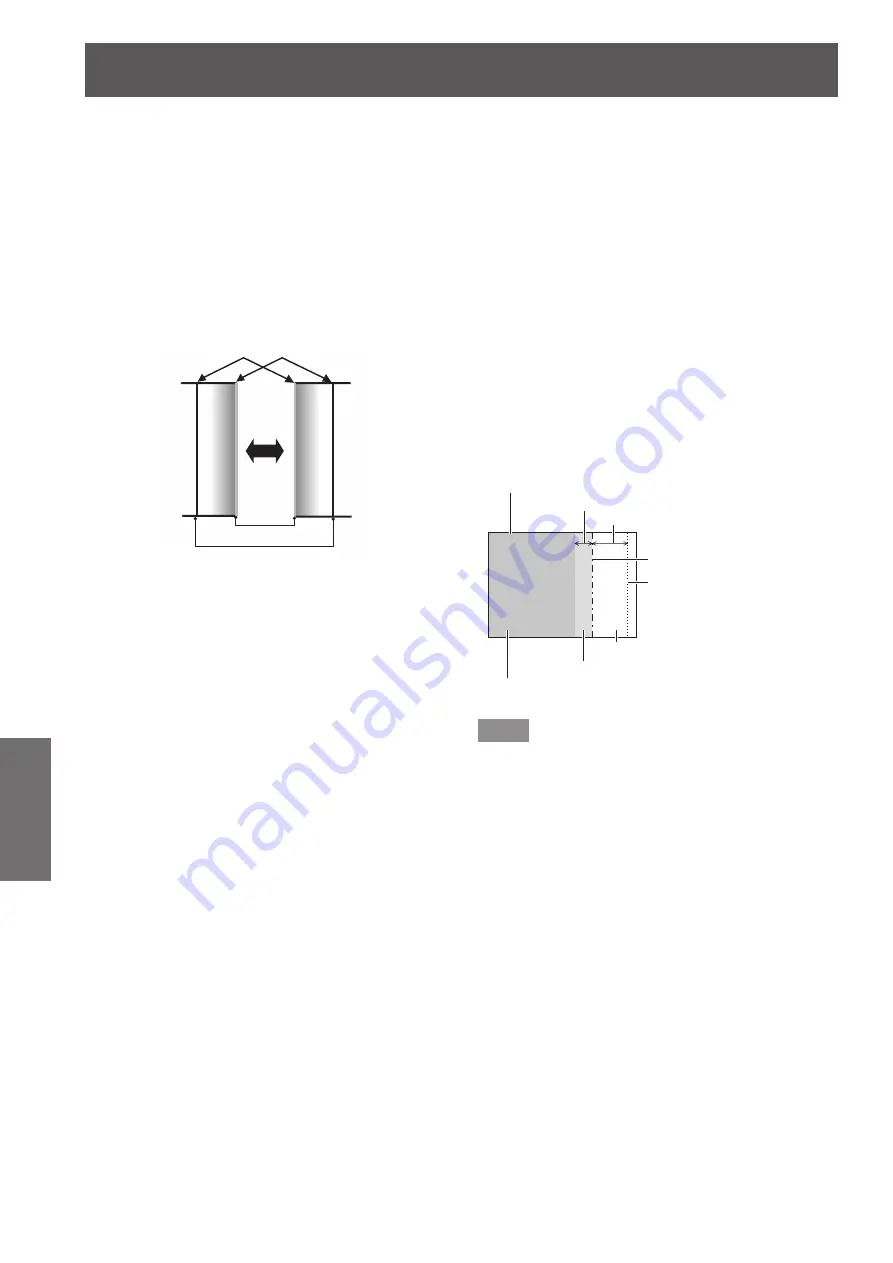
[ADVANCED MENU]
82 - ENGLISH
Settings
▶
■
To display the adjustment marker
8) Press
▲▼
to select [MARKER].
9) Press
◀▶
to switch [ON].
▶
z
A marker for image position adjustment is
displayed. The position where the red and
green lines overlap for the sets to join will be
the optimal point.
Make sure to set the correction width for the
sets to join as the same value. Optimal joining
is not possible with the sets with different
correction widths.
The optimal point is the point where this line overlaps.
Green line
Red line
10) Press
▲▼
to select [BRIGHTNESS
ADJUST].
11) Press the <ENTER> button.
▶
z
The
[BRIGHTNESS ADJUST]
screen is
displayed.
▶
z
By setting [AUTO TESTPATTERN] on the
[EDGE BLENDING] screen to [ON], the black
test pattern is displayed when you enter the
[BRIGHTNESS ADJUST] screen.
12) Press
▲▼
to select [NON-
OVERLAPPED BLACK LEVEL].
13) Press the <ENTER> button.
▶
z
The
[NON-OVERLAPPED BLACK LEVEL]
screen is displayed.
▶
z
When [INTERLOCKED] is set to [OFF], [RED],
[GREEN], and [BLUE] can be adjusted.
14) Press
▲▼
to select an item, and
press
◀▶
to adjust the setting.
▶
z
Once the adjustment is completed, press the
<MENU> button to return to the
[BRIGHTNESS
ADJUST]
screen.
15) Press
▲▼
to select [UPPER],
[LOWER], [LEFT], or [RIGHT] in
[BLACK BORDER WIDTH].
16) Press
◀▶
to set the region (width)
of the [BLACK BORDER WIDTH]
adjustment.
▶
z
When PT-DZ21KU or PT-DS20KU is used,
proceed to Step
17)
.
▶
z
When PT-DW17KU is used, proceed to Step
19)
.
17) Press
▲▼
to select [UPPER
KEYSTONE AREA], [LOWER
KEYSTONE AREA], [LEFT KEYSTONE
AREA], or [RIGHT KEYSTONE AREA].
18) Press
◀▶
to adjust the tilt of the
border between [NON-OVERLAPPED
BLACK LEVEL] and [BLACK BORDER
LEVEL].
19) Press
▲▼
to select [BLACK BORDER
LEVEL].
20) Press the <ENTER> button.
▶
z
The
[BLACK BORDER LEVEL]
screen is
displayed.
▶
z
When [INTERLOCKED] is set to [OFF], [RED],
[GREEN], and [BLUE] can be adjusted.
21) Press
▲▼
to select an item, and
press
◀▶
to adjust the setting.
>%/$&.%25'(5:,'7+@5LJKW
3URMHFWLRQUDQJH
(GJHEOHQGLQJ>:,'7+@5LJKW
>0$5.(5@5HG
(GJHEOHQGLQJ>67$57@5LJKW
>0$5.(5@*UHHQ
>%/$&.%25'(5/(9(/@
>29(5/$33('%/$&./(9(/@5LJKW
>12129(5/$33('%/$&./(9(/@
Note
z
The [BRIGHTNESS ADJUST] function makes it
harder to notice the black level of the part of the
image overlapping getting brighter when multiple
screens are set using [EDGE BLENDING]. The
optimal point of the correction is set by adjusting
[NON-OVERLAPPED BLACK LEVEL] so the black
level of the overlapping image area will be the
same level as the non-overlapping area.
If the bordering part of the part where the image
is overlapping and the non-overlapping part gets
brighter after adjusting [NON-OVERLAPPED
BLACK LEVEL], adjust the width of the top, bottom,
left, or right. Adjust [BLACK BORDER LEVEL]
when the width adjustment makes only the border
area darker.
z
The joining part may look discontinuous depending
on the position you are looking from when a screen
with high gain or rear screen is used.
z
When configuring multiple screens using
both horizontal and vertical edge blending
simultaneously, adjust [OVERLAPPED BLACK
LEVEL] first before making adjustments in Step
12)
. Adjustment method is same as the procedure
of [NON-OVERLAPPED BLACK LEVEL].
z
To use either horizontal or vertical edge blending
only, set all values of [OVERLAPPED BLACK
LEVEL] to 0.






























